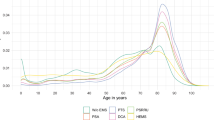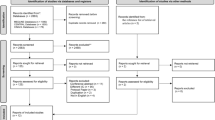Abstract
Objective
To assess patterns of intensive care reimbursement practices.
Methods
A detailed questionnaire about basic intensive care unit (ICU) characteristics and ICU reimbursement practices was created, and then members of the European Society of Intensive Care (ESICM) were asked by e-mail to participate in the survey and complete the web-based questionnaire.
Results
There were a total of 447 responses analyzed. Of respondents, 51.5% stated that their ICU received detailed financial information; however, only 15.4% of respondents could identify each cost item for each patient. A majority of respondents (77.6%) stated that their unit’s reimbursement system was included in the hospital reimbursement. ICU reimbursement systems were most commonly based on previous year’s ICU expenditure (51.0%) and diagnosis-related group weights (36%). Selecting European respondents (n = 306) showed that supplying detailed financial information makes ICU doctors significantly more satisfied (p = 0.019) with their reimbursement system. Regarding ICU funding elements, the most satisfied with their ICU reimbursement system were those respondents from ICUs where nursing workload score was used (p = 0.018).
Conclusions
Our result indicates that ICU physicians who receive detailed financial information about their units are more satisfied with their reimbursement system than those not receiving this information. Nursing workload score may have advantage over other forms of reimbursement practices. ICU physicians would like to be more involved in their unit’s financial aspects and would prefer separate funding from hospital.
Similar content being viewed by others
References
Neilson AR, Moerer O, Burchardi H, Schneider H (2004) A new concept for DRG-based reimbursement of services in German intensive care units: results of a pilot study. Intensive Care Med 30:1220–1223
Colin C, Geffroy L (1997) The health system: reform wanted by government and expected by patients. Lancet 349:791–797
Iapichino G, Radrizzani D, Bertolini G, Ferla L, Pasetti G, Pezzi A, Porta F, Miranda DR (2001) Daily classification of the level of care. A method to describe clinical course of illness, use of resources and quality of intensive care assistance. Intensive Care Med 27:131–136
Halpern NA, Pastores SM, Greenstein RJ (2004) Critical care medicine in the United States 1985–2000: an analysis of bed numbers, use and costs. Crit Care Med 32:1408–1409
Ridley S, Morris S (2007) Cost effectiveness of adult intensive care in the UK. Anaesthesia 62:547–554
Statins for the Prevention of Cardiovascular Events. Technology Appraisal 94, by the National Institute for Health and Clinical Excellence, London. http://www.nice.org.uk/nicemedia/pdf/TA094guidance.pdf. Accessed September 2009
Iglehart JK (1983) Medicare begins prospective payment for hospitals. NEJM 308:1428–1432
Cooper LM, Linde-Zwirble WT (2004) Medicare intensive care unit use: analysis of incidence, cost, and payment. Crit Care Med 32:2247–2253
Csomos A, Lendvai A, Ökrös I (2002) Comparison of DRG system funding and actual costs for intensive care in Hungary. Critical Care 6:S115
Schreyögg J, Tiemann O, Busse R (2006) Cost accounting to determine prices: how well do prices reflect costs in the German DRG-system? Health Care Manage Sci 9:269–279
Negrini D, Sheppard L, Mills GH, Jacobs P, Rapoport J, Bourne RS, Guidet B, Csomos A, Prien T, Anderson G, Edbrooke DL (2006) International Programme for Resource use in Critical care (IPOC)—a methodology and initial results of cost and provision in four European countries. Acta Anaesth Scand 50:72–79
Dickie H, Vedio A, Dundas R, Treacher DF, Leach RM (1998) Relationship between TISS and costs in intensive care. Intensive Care Med 24:1009–1017
de Keizer NF, Bonsel GJ, Al MJ, Gemke RJ (1998) The relation between TISS and real paediatric ICU costs: a case study with generalizable methodology. Intensive Care Med 24:1062–1069
Kaufmann I, Briegel J (2000) Therapeutic Intervention Scoring System (TISS)—a method for calculating costs in the intensive care unit and intermediate care unit. Crit Care 4:S139
Graf J, Graf C, Janssens U (2002) Analysis of resource use and cost-generating factors in a German medical intensive care unit employing the Therapeutic Intervention Scoring System (TISS-28). Intensive Care Med 28:324–331
Hoehn T, Drabik A, Lehmann C, Christaras A, Stannigel H, Mayatepek E (2008) Correlation between severity of disease and reimbursement of costs in neonatal and paediatric intensive care patients. Acta Paediatr 97:1438–1442
Acknowledgments
Authors would like to thank those ESICM members who participated in this survey.
Members of the Steering Committee
Akos Csomos, Hungary; Guido Bertolini, Italy; Hilmar Burchardi, Germany; Maurizia Capuzzo, Italy; Bertrand Guidet, France; Clare Hibbert, UK; Philipp Metnitz, Austria.
Author information
Authors and Affiliations
Corresponding author
Additional information
On behalf of the Research Group on Health Economics of the European Society of Intensive Care Medicine (ESICM).
Electronic supplementary material
Below is the link to the electronic supplementary material.
Rights and permissions
About this article
Cite this article
Csomos, A., Varga, S., Bertolini, G. et al. Intensive care reimbursement practices: results from the ICUFUND survey. Intensive Care Med 36, 1759–1764 (2010). https://doi.org/10.1007/s00134-010-1911-8
Received:
Accepted:
Published:
Issue Date:
DOI: https://doi.org/10.1007/s00134-010-1911-8




